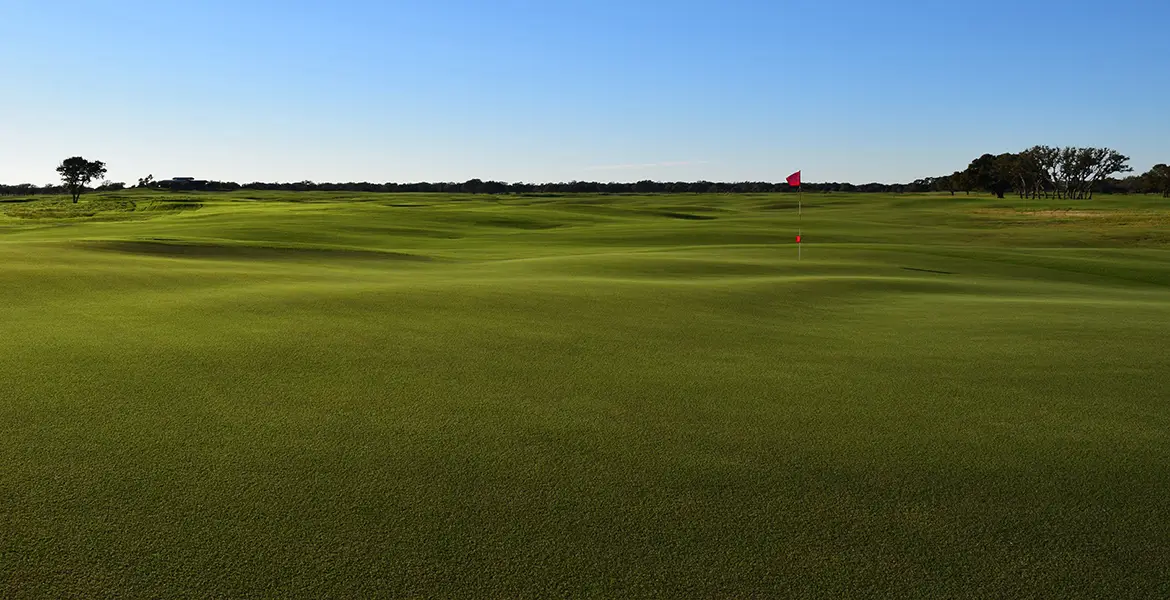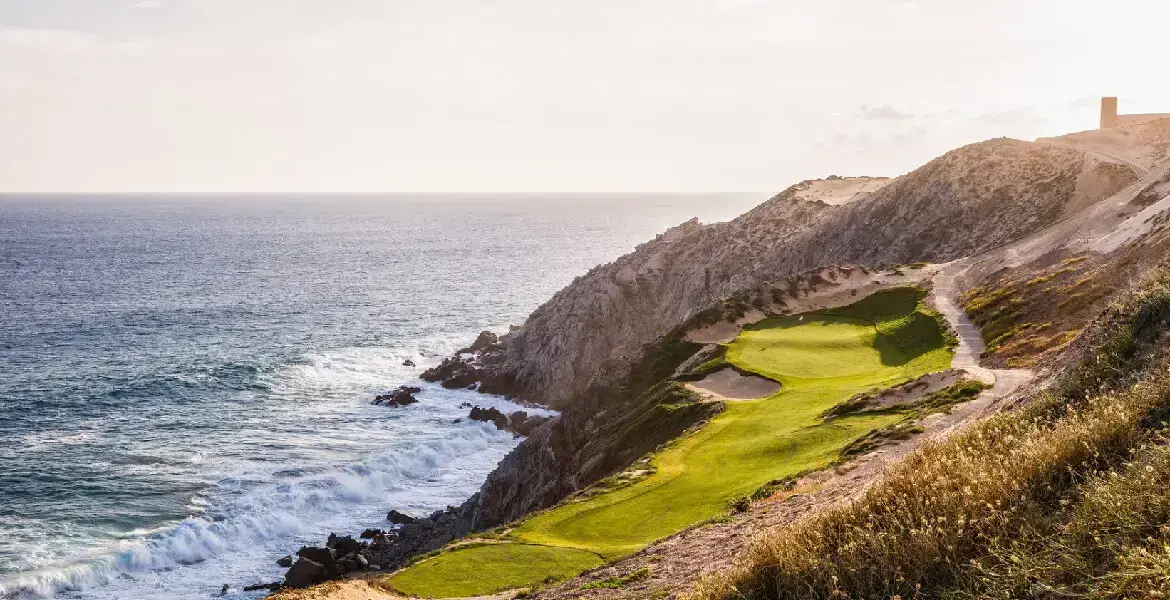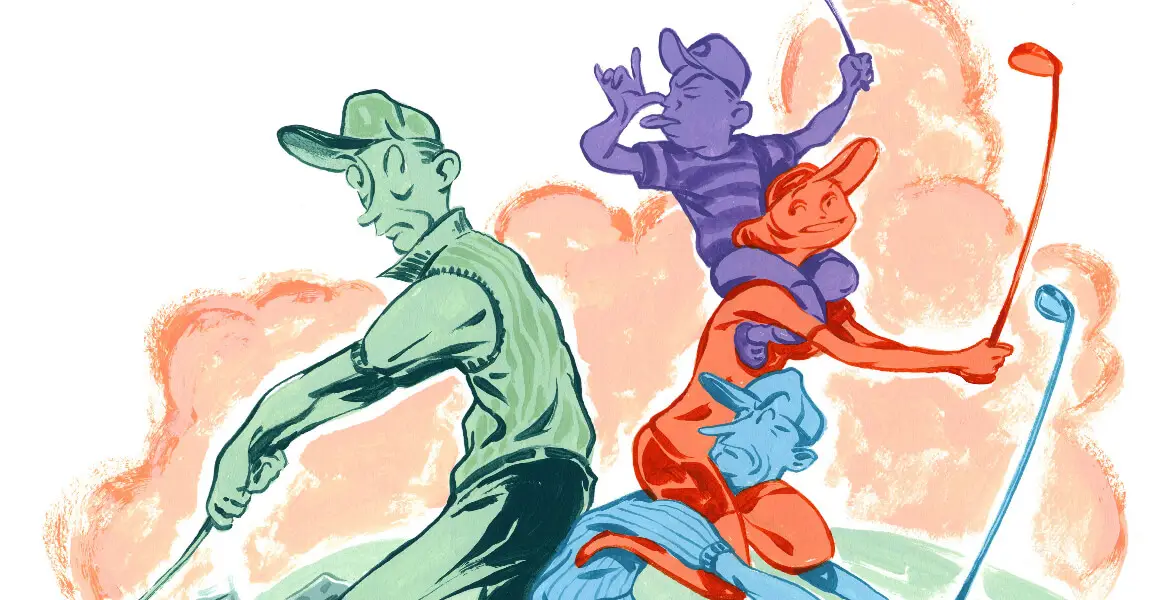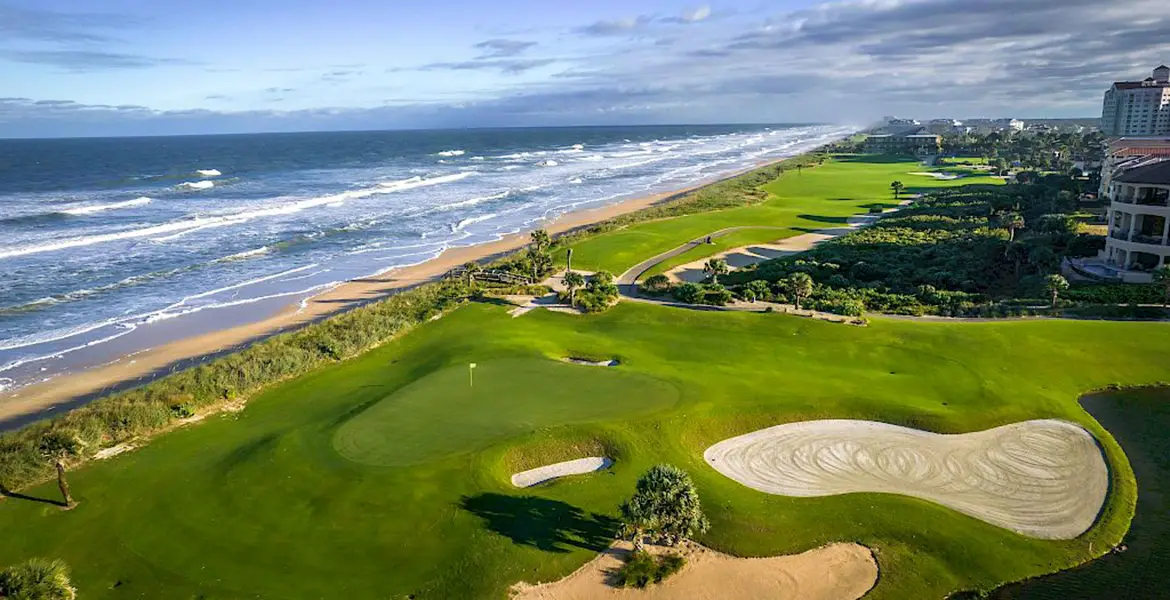Many clubs relish the opportunity to host significant professional and amateur championships. An elite few completely embrace the role. Over the past century, a fistful of clubs has added to the lore of the game by doing double duty, hosting significant professional or amateur championships on at least two different courses at the club.
Here are the top 10 clubs that have played host to golf’s most prestigious competitions at two different courses.
Winged Foot (East and West)—Mamaroneck, N.Y.
East: U.S. Women’s Open (1957, 1972); U.S. Senior Open (1980)
West: U.S. Open (1929, 1959, 1974, 1984, 2006, 2020); PGA Championship (1997); U.S. Amateur (1940, 2004)
Given the edict to “build us a man-sized” course, A.W. Tillinghast did just that with both courses in 1923. With the West, he created a stern, yet graceful test with lengthy par fours and frighteningly deep bunkers guarding imaginatively contoured greens. Among its six U.S. Opens, Bobby Jones’s miraculous downhill, 12-foot, left-to-right-breaking putt in 1929 to earn a playoff stands out.
Neither as long nor as tough as its illustrious West sibling, the equally attractive East is preferred by many course connoisseurs for its superior pacing and variety. No stranger to big-time events, the A.W. Tillinghast-designed East witnessed Roberto DeVicenzo claim the very first U.S. Senior Open here in 1980. A 2015 restoration by Gil Hanse put back many of the most ingenious green contours that had been lost or changed over time.
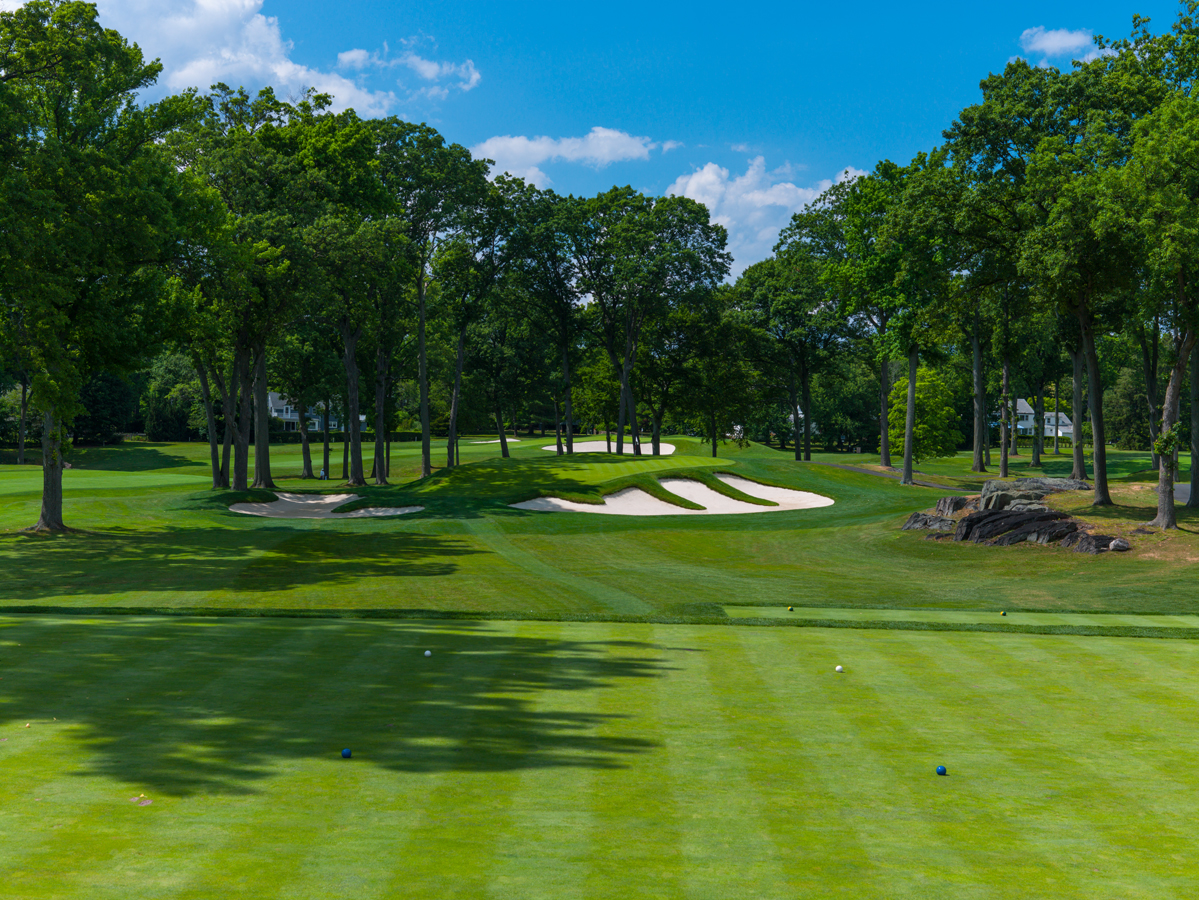
Baltusrol (Lower and Upper)—Springfield, N.J.
Lower: U.S. Open (1954, 1967, 1980, 1993); PGA Championship (2005, 2016); U.S. Women’s Open (1961); KPMG Women’s PGA Championship (2023); U.S. Amateur (1926, 1946)
Upper: U.S. Open (1936); U.S. Women’s Open (1985); U.S. Amateur (2000)
Restored in 2021 by Gil Hanse, the sturdy, leafy A.W. Tillinghast-designed Lower course at Baltusrol enthralled 21st century fans with its well-bunkered heft during the 2005 PGA Championship when Phil Mickelson triumphed in the heat. His flop shot wedge from deep rough to two feet at the final hole gave him a one-shot victory. Sports Illustrated once named the Lower’s par-three 4th the best 4th hole in the U.S. The Lower’s unusual finish, back-to-back par fives, has twice ushered Jack Nicklaus into the U.S. Open winner’s circle.
If its brawnier sibling, the Lower, is considered the premier tournament track, the mountainside Tillinghast-designed Upper layout is much more fun, with its beguiling set of sloping greens and sidehill lies all parts of the puzzle to be solved. Byron Nelson, Gene Sarazen, and Tommy Armour were all in the field when the Upper hosted the 1936 U.S. Open, but little-known Tony Manero emerged the winner. An acclaimed Gil Hanse restoration of the Upper in 2025 will no doubt lead to greater tournament glory for the club.
Philadelphia Cricket Club (St. Martins and Wissahickon)—Flourtown, Pa.
St. Martins: U.S. Open (1907, 1910)
Wissahickon: Constellation Senior Players Championship (2016); Truist Championship (2025)
The only club in the United States with a different golf course constructed in each of the last three centuries, Philadelphia Cricket Club is considered the oldest country club in America, with facilities that date to 1854. The club occupies two campuses, the original in the Chestnut Hill section of Philadelphia and its more recently built (103 years ago!) 36-hole facility in suburban Flourtown. Its first golf course, now known as St. Martins, was a 9-hole track created in 1895. It soon gave way to a Willie Tucker-designed 18-hole layout in 1898, which incorporated several holes from the old nine. That 18-hole course hosted two U.S. Opens, the first in 1907, when Alec Ross—brother of legendary architect Donald Ross—won the title. In 1910, Alex Smith won his second U.S. Open, one of 10 top-five finishes he posted in the U.S. Open between 1898 and 1921.
In danger of its St. Martins course becoming obsolete, and without sufficient room to expand, Philly Cricket Club responded with an entirely new facility in Flourtown and added an 18-hole course designed by club member A.W. Tillinghast. Not long after Tillinghast’s course—known now as Wissahickon—took hold, nine holes of St. Martins were abandoned for cost savings reasons. In 2002, at the Flourtown facility, the Militia Hill course debuted, designed by Michael Hurdzan and Dana Fry. Renewed interest and ranking glory emerged for the Wissahickon course after a 2013–14 restoration by Keith Foster. Bernhard Langer captured a senior major there in 2016, and Sepp Straka won a PGA Tour event there in 2025, when it served as a hugely praised substitute for Quail Hollow on the calendar—which played host instead to the PGA Championship. Foster took time in 2013 to refine and restore the St. Martins course as well, which continues to utilize golf holes from its ancient U.S. Open days.
Bandon Dunes (Bandon Dunes and Pacific Dunes)—Bandon, Ore.
Bandon Dunes: U.S. Amateur (2020); U.S. Women’s Amateur (2025)
Pacific Dunes: Curtis Cup (2006)
With Mike Keiser’s vision and young Scottish architect David McLay Kidd’s execution, Bandon Dunes is the course that put remote Bandon Dunes Golf Resort on the map in 1999, proving the adage, “If you build it, they will come.” Draped atop Pacific Ocean bluffs, the firm, fast-running, linksy layout brought the entire Scottish experience—walking with caddies, ground game, wind, fescue grasses—to America. All the virtues of Bandon Dunes’s original layout were on display during its acclaimed stint as host to the 2020 U.S. Amateur, won in dramatic fashion by Tyler Strafaci. Wily rising Stanford senior Megha Ganne solved all the riddles posed in capturing the 2025 U.S. Women’s Amateur here.
Pacific Dunes is a 2001 Tom Doak creation that checks in as one of the greatest modern designs in the world. Ranked No. 42 in The LINKS 100, it fits so majestically into its billowing terrain, it looks like it’s been there 100 years. Scattered blow-out bunkers, gigantic natural dunes, smartly contoured greens and Pacific panoramas are headliners. It proved to be a stirring host for the Curtis Cup in 2006, when the U.S. defeated Great Britain and Ireland 11 1/2 to 6 1/2, with current Golf Channel commentator Paige Mackenzie earning three points for the Yanks.
Atlanta Athletic Club (Highlands and Riverside)—Johns Creek, Ga.
Highlands: U.S. Open (1976); PGA Championship (1981, 2001, 2011); KPMG Women’s PGA Championship (2021); U.S. Amateur (2014)
Riverside: U.S. Women’s Open (1990)
Atlanta Athletic Club was the original and longtime home club for the immortal Bobby Jones. However, until 1967, the club was located in the heart of Atlanta, where it is now known as East Lake, home to the PGA Tour Championship. It was at the East Lake facility where the 1963 Ryder Cup took place. Robert Trent Jones Sr. designed 27 holes in 1967, which became the Riverside course and nine of the Highlands. Joe Finger added nine more in 1971 to create the Highlands 18. In subsequent years, the Highlands layout was renovated by the Fazios and notably Rees Jones, and over the years it witnessed some of the greatest shots in major championship history, including Jerry Pate’s towering 5-iron over-the-water approach at the 72nd hole which clinched the 1976 U.S. Open, as well as David Toms’s 5-wood ace at the 243-yard 15th during the third round of the 2001 PGA Championship, an event he would win in dramatic fashion the following day. Andrew Green has signed on to renovate Highlands in the coming years.
Riverside has usually yielded to its brawnier sibling, but a Tripp Davis renovation in 2022 injected loads of character into the layout, making it a worthy—and near-equal in some minds—companion to its Highlands sibling. With improved playability and the enhanced influence of the Chattahoochee River, Riverside more than holds its own. Hall of Famer Betsy King charged from five shots back to nip fellow Hall of Famer Patty Sheehan by one to win the 1990 U.S. Women’s Open at Riverside.
Kohler Wisconsin (Whistling Straits and Blackwolf Run)—Kohler, Wis.
Whistling Straits (Straits): PGA Championship (2004, 2010, 2015); Ryder Cup (2021); U.S. Senior Open (2007)
Blackwolf Run: U.S. Women’s Open (1998, 2012)
Boasting eight holes overlooking Lake Michigan (or what the caddies call the “Sea of Wisconsin”), the Straits course at Whistling Straits is remarkable in every respect. Home to three PGA Championships—won by Vijay Singh, Martin Kaymer, and Jason Day—and to the U.S. victory at the 2021 Ryder Cup, this 1998 Pete Dye design boasts 70-foot fescue-cloaked sandhills, more than 1,000 bunkers, and a course rating and slope so high they could produce nosebleeds.
Closer to the main American Club hotel at Kohler are the two Pete Dye courses at Blackwolf Run—River and Meadow Valleys. Often an afterthought to its sibling, Whistling Straits, Blackwolf Run played host to the 1998 and 2012 U.S. Women’s Opens. Dye’s typically penal hard edges along water hazards, ligament-snapping rough, and nasty, steep, grass-faced bunkers are angst-inducing, but memorable holes abound. In both U.S. Women’s Opens, the property’s original 18 holes were employed for better gallery movement. Holes 10–18 of Meadow Valleys served as the outgoing nine and River’s 1–4 and 14–18 served as the incoming nine.
Monterey Peninsula Country Club (Dunes and Shore)—Pebble Beach, Calif.
Dunes: Co-host, Bing Crosby Pro-Am (Now AT&T Pebble Beach Pro-Am) from 1947–64
Shore: Co-host, AT&T Pebble Beach Pro-Am (1965, 1966, 1977, 2010-20, 2022, 2023)
Blessed with excellent bones and a remarkable architectural pedigree, the Dunes was a mainstay as co-host for the PGA Tour’s Bing Crosby National Pro-Am for nearly two decades after World War II. Seth Raynor designed the Dunes, but he died early in construction, in 1926, and it was finished by Alister MacKenzie’s partner, Robert Hunter. However, even with its dunes, ocean holes, handsome trees, and deer prancing everywhere, it never quite realized its early potential, even after some Rees Jones alterations in 1998. Enter Tom Fazio, who teamed with former associates Tim Jackson and David Kahn to perform an extreme makeover in 2016. Greens were recontoured and reconfigured, dunescapes were enhanced and new ones added, with greater variety and memorability the result. The Dunes course has also hosted five USGA Championships, among them the 1952 U.S. Girls Junior won by future legend Mickey Wright and the 2025 U.S. Women’s Mid-Amateur, when Ina Kim-Schaad captured her second title.
Constructed on a shoestring budget, the Shore course opened in 1961 with a Bob Baldock/Jack Neville design. The Shore course joined the rota for the AT&T Pebble Beach National Pro-Am in 2010, replacing Poppy Hills. Its current character is all Mike Strantz, the late designer who finished an amazing makeover in 2003–04. Strantz carved out 12 new holes and reworked six others and the rock formations, twisted trees, and unimpeded ocean views boosted the course into everybody’s top 100. It ranks 88th in the current LINKS 100.
French Lick Resort (Donald Ross and Pete Dye)—French Lick, Ind.
Donald Ross: PGA Championship (1924); LPGA Championship (1959, 1960)
Pete Dye: Senior PGA Championship (2015)
Donald Ross’s museum piece dates to 1920 and little on the open, rolling landscape has changed since, thanks to a 2005 restoration by Hoosier native Lee Schmidt of Schmidt-Curley Design. Walter Hagen won the 1924 PGA Championship here, in Larry Bird’s hometown, beating Long Jim Barnes in the final. Barnes three-putted four times in the morning round, an easy thing to do on these slick, plateaued, wildly contoured putting surfaces. Two other Hall of Famers captured majors on the LPGA Tour here with Betsy Rawls winning the 1959 LPGA Championship and Mickey Wright winning that same event in 1960.
You’ll need local hero Larry Bird’s long-range touch to cope with the 8,100-yard Pete Dye-designed brute that opened in 2009 and plays atop ridges and through valleys amid the rolling countryside of southern Indiana. Rough-covered sidehill lies and a fistful of volcano bunkers will drain any golfer—except perhaps Colin Montgomerie, who captured the 2015 Senior PGA Championship here.
Silverado Resort (North and South)—Napa, Calif.
North: PGA Tour events (1968–80 and 2014–present)
South: PGA Tour Champions events (1989–2002)
The Kaiser and Anheuser-Busch PGA Tour events of the 1960s, ’70s, and ’80s, like the more recent Frys.com, Safeway, Fortinent, and Procore Championship tournaments, utilized Silverado’s North Course. The layout dates to 1955, but it was substantially reworked by Robert Trent Jones Jr., under the umbrella of his father’s firm, in 1967. Johnny Miller, then a resident and co-owner, added his own design changes in 2011 and beyond, including bumping the back-tee length from 6,836 yards to 7,166. Miller was victorious here in 1974 and 1975. Legends like Jack Nicklaus, Billy Casper, Tom Watson, and Ben Crenshaw also hoisted the trophy in those early years. Recent winners include Max Homa who went back-to-back in 2021–22 and Scottie Scheffler, the 2025 champion.
Despite its less-than-gargantuan length by today’s standards, Silverado North amply tests the game’s best. The flattish course yields one of the easiest-to-walk Tour layouts, making it an enjoyable stroll for pros, caddies, and spectators alike. The primary challenge comes from the firm, quick, canted greens, which are well guarded by medium-size bunkers that alternate between framing and protruding. Mature, ancient trees form the other main obstacle, together with a smattering of creeks and ponds. It all looks pretty simple, but its straightforward appeal belies the bogies that inevitably creep in from a wayward shot.
Just because the North course hosts the PGA Tour doesn’t mean you should sleep on the South course. Though only 6,612 yards from the tips, the South delivers much more elevation change, as well as additional water hazards. The South was home to the PGA Tour Champions from 1989–2002. Among the victors of the Transamerica event were major championship winners Billy Casper, Charles Coody, Bob Charles, Dave Stockton, and Tom Kite. A Texan named Lee Trevino won it twice, in 1990 and 1995. We’re talking seriously famous footsteps. Johnny Miller has long admired the par-five 11th, a 565-yarder with water running up the left side.
The Greenbrier (Greenbrier and Old White)—White Sulphur Springs, W.Va.
Greenbrier: Ryder Cup (1979); Solheim Cup (1994)
Old White: PGA Tour’s Greenbrier Classic (2010–19)
The Greenbrier course at the Greenbrier was a 1924 Seth Raynor creation that was comprehensively redesigned in 1977 by Jack Nicklaus. Host to the 1979 Ryder Cup, where Larry Nelson went 5–0–0 in leading the U.S. to a 17–11 victory, and to the 1994 Solheim Cup, with Dottie Pepper Mochrie the dominant star in a 13–7 U.S. triumph, the course plays through an Allegheny Mountain valley lined with maples, oaks, and pines. The Greenbrier course remains open to resort guest play but was reduced to 10 holes following storms and a flood in 2017.
Following a sensitive 2007 restoration by Lester George, the 1914 C.B. Macdonald/Seth Raynor effort at The Old White course has charmed and wowed fans of Golden Age golf. The PGA Tour played the Greenbrier Classic here from 2010 through 2019, except for 2016, when flooding closed the course and cancelled the tournament. Amid undulating terrain in the foothills of the forested Allegheny Mountains, players delighted in the classic templates, such as the Redan par-three 8th, Punchbowl par-four 9th, and Eden par-three 15th. The course closes in an unusual fashion, with a par three that measures 179 yards. Winners of the PGA Tour event included Angel Cabrera, Xander Schauffele and Joaquin Niemann.


